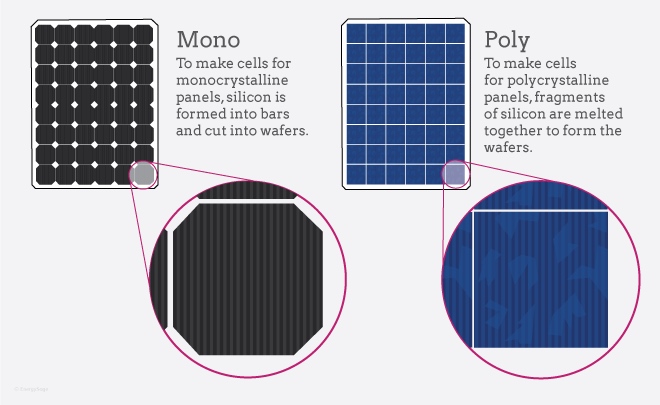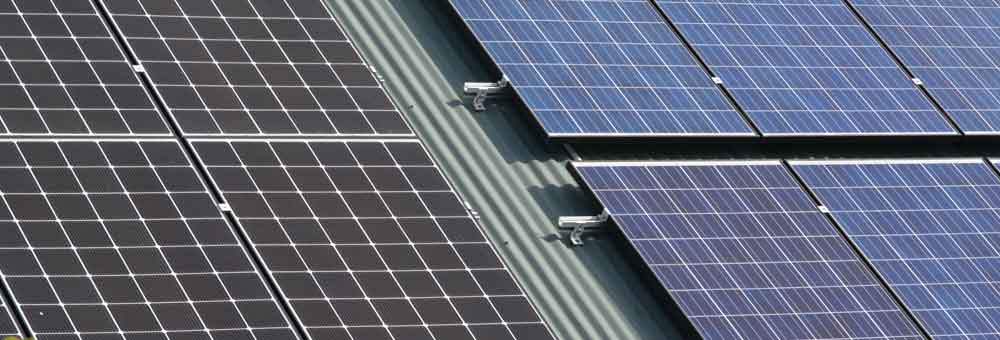Last update July 10th, 2024 at 06:21 pm
If you plan to install a solar panel system, you will find several solar technology types to choose from. In the Australian solar market, you are able to choose between three panel types. Thin-film, monocrystalline and polycrystalline solar panels.
Thin-film solar panels are usually not recommended. This is because they are less effective than the two others. For most people, the choice is between mono- and polycrystalline solar panels.
So, which one should you go for?
Here you will learn about monocrystalline and polycrystalline solar panels. We will cover what differentiates them from each other. we help you find the right solar panel type for your home. Based on the efficiency, price, design and sustainability of each panel type.

Polycrystalline solar panels
A polycrystalline solar panel cell usually consists of several silicon pieces blended together. Small silicon bits bond together under heat so the amalgam consists of many crystals.
Aesthetics and design
Polycrystalline solar panel cells have a distinct blue colour due to the blending. When looking at the solar panel you might be able to see that the colour is uneven.
Less efficient
Compared to monocrystalline solar panels, polycrystalline panels are less efficient. Imperfections that can be on the solar cell surface. The efficiency rate is usually around 13 to 17% for polycrystalline solar panels.
Lower cost
On the positive side, polycrystalline solar panels cost less than monocrystalline solar panels. The exact price will depend on the system size, manufacturer and other factors.
You need more panels to produce the same power output delivered by monocrystalline panels. But, the total cost will usually be lower if we look at the price dollar cost per watt.
More sustainable production process compared to monocrystalline solar panels
There is less waste associated with the production of polycrystalline solar panels. This also makes them the most sustainable option.

Monocrystalline solar panels
A monocrystalline solar panel will usually contain solar cells cut from a single type of crystalline silicon ingot. The silicon in the cells is the highest purity, like a semiconductor.
Aesthetics and design
The monocrystalline solar panels have a uniform, dark look. Many people think this gives them a more appealing aesthetic, although this is a matter of personal preference.
More efficient
The cells are purer and more efficient than polycrystalline solar panels. The efficiency rate is in most cases in the range of 18 to 22%.
The monocrystalline solar panel also has better performance in hot or low-light environments. They will have a higher power output than polycrystalline solar panels if installed in a place with harsh weather conditions.
Also, note that monocrystalline systems need somewhat less space than polycrystalline systems. This is because they are more efficient, and you will so need fewer panels to produce the same amount of power.
Higher cost
Although monocrystalline solar panels are more efficient, they are more expensive to produce. These solar panels are more expensive to buy than polycrystalline solar panels of the same size.
Less sustainable than polycrystalline panels
The manufacturing process of monocrystalline solar panels is less sustainable than the production of polycrystalline panels. This is because of a higher production of waste, due to the cutting and shaving of the corners.
A monocrystalline solar panel comes from a square silicon wafer. To give the solar panel cells their distinct look and cell shape, with the corners shaved off.
Which one is better: Monocrystalline or polycrystalline solar panels?
If you are going to invest in a new solar panel system, it might be a good idea to buy monocrystalline solar panels. Monocrystalline solar cells have the most efficient production process because they come from a single silicon source.
Many people also think that monocrystalline solar panels look better due to their uniform, black design.
Polycrystalline solar cells consist of several silicon sources blended together which makes them less efficient. They also have a blue colour, and some people think they look less appealing.
At the same time, polycrystalline solar panels are usually more affordable and sustainable than monocrystalline solar panels.
In conclusion, if you consider efficiency or design to be the most important factor. A monocrystalline solar panel is your best choice.